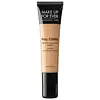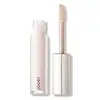Make Up For Ever Full Cover Concealer Versus Jouer Cosmetics Essential High Coverage Liquid Concealer
What's inside
What's inside
 Key Ingredients
Key Ingredients

 Benefits
Benefits

 Concerns
Concerns

 Ingredients Side-by-side
Ingredients Side-by-side

Water
Skin ConditioningPolyglyceryl-3 Diisostearate
EmulsifyingIsododecane
EmollientCyclopentasiloxane
EmollientGlycerin
HumectantPolyethylene
AbrasiveDisteardimonium Hectorite
StabilisingMicrocrystalline Cellulose
AbsorbentTalc
AbrasivePhenoxyethanol
PreservativeSodium Myristoyl Glutamate
CleansingMagnesium Sulfate
Silica Dimethyl Silylate
EmollientSodium Chloride
MaskingXanthan Gum
EmulsifyingPropylene Carbonate
SolventChlorphenesin
AntimicrobialMethylparaben
PreservativePropylparaben
PreservativeSodium Dehydroacetate
PreservativeOctyldodecyl Myristate
EmollientCapparis Spinosa Fruit Extract
Skin ConditioningAllantoin
Skin ConditioningDimethicone/Vinyl Dimethicone Crosspolymer
Skin ConditioningTetrasodium EDTA
Aluminum Hydroxide
EmollientBHT
AntioxidantCI 19140
Cosmetic ColorantCI 42090
Cosmetic ColorantCI 77007
Cosmetic ColorantCI 77163
Cosmetic ColorantCI 77491
Cosmetic ColorantCI 77492
Cosmetic ColorantCI 77499
Cosmetic ColorantCI 77891
Cosmetic ColorantWater, Polyglyceryl-3 Diisostearate, Isododecane, Cyclopentasiloxane, Glycerin, Polyethylene, Disteardimonium Hectorite, Microcrystalline Cellulose, Talc, Phenoxyethanol, Sodium Myristoyl Glutamate, Magnesium Sulfate, Silica Dimethyl Silylate, Sodium Chloride, Xanthan Gum, Propylene Carbonate, Chlorphenesin, Methylparaben, Propylparaben, Sodium Dehydroacetate, Octyldodecyl Myristate, Capparis Spinosa Fruit Extract, Allantoin, Dimethicone/Vinyl Dimethicone Crosspolymer, Tetrasodium EDTA, Aluminum Hydroxide, BHT, CI 19140, CI 42090, CI 77007, CI 77163, CI 77491, CI 77492, CI 77499, CI 77891
Cyclopentasiloxane
EmollientWater
Skin ConditioningButylene Glycol
HumectantPvp
Emulsion StabilisingPhenyl Trimethicone
Skin ConditioningCetyl PEG/PPG-10/1 Dimethicone
EmulsifyingPEG-10 Dimethicone
Skin ConditioningVinyl Dimethicone/Methicone Silsesquioxane Crosspolymer
Quaternium-18 Hectorite
Sorbitan Isostearate
EmulsifyingDimethicone
EmollientSodium Chloride
MaskingTriethoxycaprylylsilane
Caprylyl Glycol
EmollientPhenoxyethanol
PreservativeCitric Acid
BufferingSorbitol
Humectant1,2-Hexanediol
Skin ConditioningPropanediol
SolventSodium Phytate
Illicium Verum Fruit Extract
PerfumingTocopheryl Acetate
AntioxidantSodium Hyaluronate
HumectantEuterpe Oleracea Fruit Extract
CI 77891
Cosmetic ColorantCI 77491
Cosmetic ColorantCI 77492
Cosmetic ColorantCI 77499
Cosmetic ColorantCyclopentasiloxane, Water, Butylene Glycol, Pvp, Phenyl Trimethicone, Cetyl PEG/PPG-10/1 Dimethicone, PEG-10 Dimethicone, Vinyl Dimethicone/Methicone Silsesquioxane Crosspolymer, Quaternium-18 Hectorite, Sorbitan Isostearate, Dimethicone, Sodium Chloride, Triethoxycaprylylsilane, Caprylyl Glycol, Phenoxyethanol, Citric Acid, Sorbitol, 1,2-Hexanediol, Propanediol, Sodium Phytate, Illicium Verum Fruit Extract, Tocopheryl Acetate, Sodium Hyaluronate, Euterpe Oleracea Fruit Extract, CI 77891, CI 77491, CI 77492, CI 77499
Ingredients Explained
These ingredients are found in both products.
Ingredients higher up in an ingredient list are typically present in a larger amount.
Ci 77491 is also hydrated iron III oxide. It's sole purpose is to give a red/pink hue to products.
Iron III oxides are classified as inorganic chemicals for coloring.
Synthetically created Ci 77491 is considered safer than those naturally found. This is because the synthetically created version may contain less impurities. Iron oxides are generally non-toxic and non-allergenic.
Learn more about CI 77491Ci 77492 is also hydrated iron III oxide. It's sole purpose is to give a yellow hue to products.
Iron III oxides are classified as inorganic chemicals for coloring.
Synthetically created Ci 77492 is considered safer than those naturally found. This is because the synthetically created version may contain less impurities. Iron oxides are generally non-toxic and non-allergenic.
Learn more about CI 77492Ci 77499 is also hydrated iron III oxide. It is created from mixing red and black iron oxides. This helps give shades of darkness to a product.
Iron III oxides are classified as inorganic chemicals for coloring.
Ci 77891 is a white pigment from Titanium dioxide. It is naturally found in minerals such as rutile and ilmenite.
It's main function is to add a white color to cosmetics. It can also be mixed with other colors to create different shades.
Ci 77891 is commonly found in sunscreens due to its ability to block UV rays.
Learn more about CI 77891Cyclopentasiloxane, or D5, is a silicone used to improve texture of products and trap moisture.
D5 is considered lightweight and volatile. Volatile means it evaporates quickly after application. Once evaporated, D5 leaves a thin barrier that helps keep skin hydrated.
It is also an emollient. Emollients help soften the skin and prevent water loss. Silicones create a silky texture in products. D5 helps other ingredients become more spreadable.
Studies show D5 is safe to use in skincare products. We recommend speaking with a skincare professional if you have concerns.
Learn more about CyclopentasiloxanePhenoxyethanol is a preservative that has germicide, antimicrobial, and aromatic properties. Studies show that phenoxyethanol can prevent microbial growth. By itself, it has a scent that is similar to that of a rose.
It's often used in formulations along with Caprylyl Glycol to preserve the shelf life of products.
Chances are, you eat sodium chloride every day. Sodium Chloride is also known as table salt.
This ingredient has many purposes in skincare: thickener, emulsifier, and exfoliator.
You'll most likely find this ingredient in cleansers where it is used to create a gel-like texture. As an emulsifier, it also prevents ingredients from separating.
There is much debate on whether this ingredient is comedogenic. The short answer - comedogenic ratings don't tell the whole story. Learn more about comegodenic ratings here.
The concensus about this ingredient causing acne seems to be divided. Research is needed to understand if this ingredient does cause acne.
Scrubs may use salt as the primary exfoliating ingredient.
Learn more about Sodium ChlorideWater. It's the most common cosmetic ingredient of all. You'll usually see it at the top of ingredient lists, meaning that it makes up the largest part of the product.
So why is it so popular? Water most often acts as a solvent - this means that it helps dissolve other ingredients into the formulation.
You'll also recognize water as that liquid we all need to stay alive. If you see this, drink a glass of water. Stay hydrated!
Learn more about Water